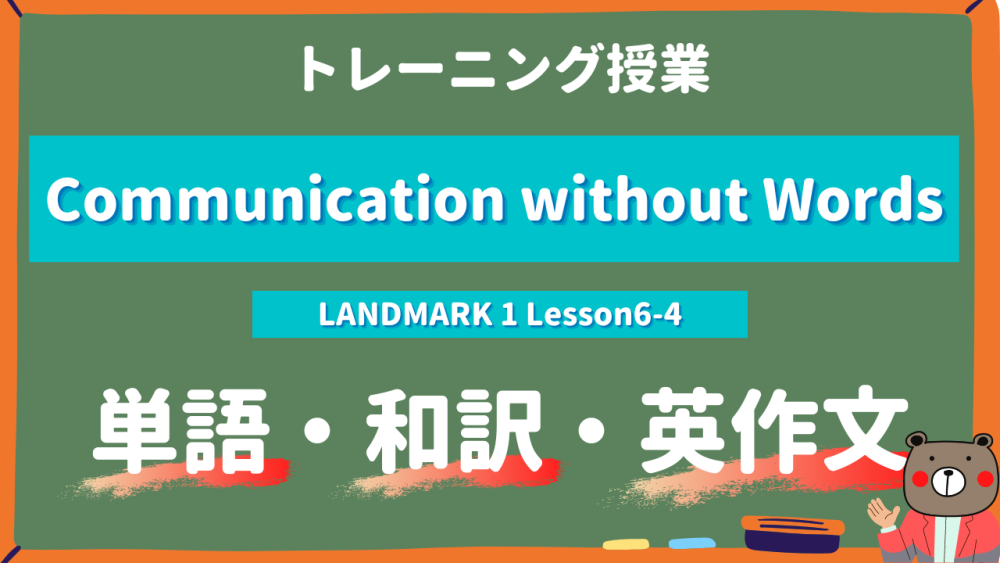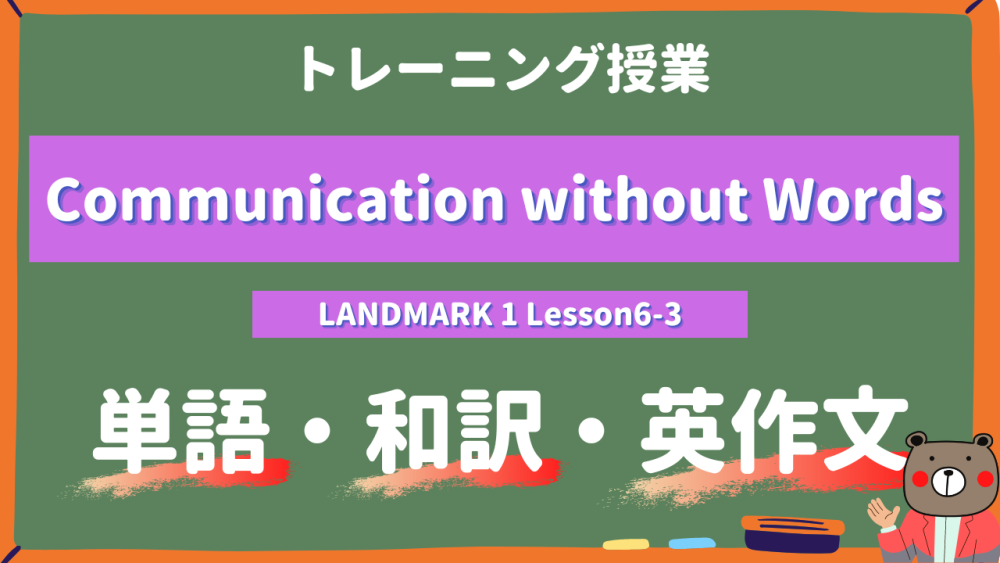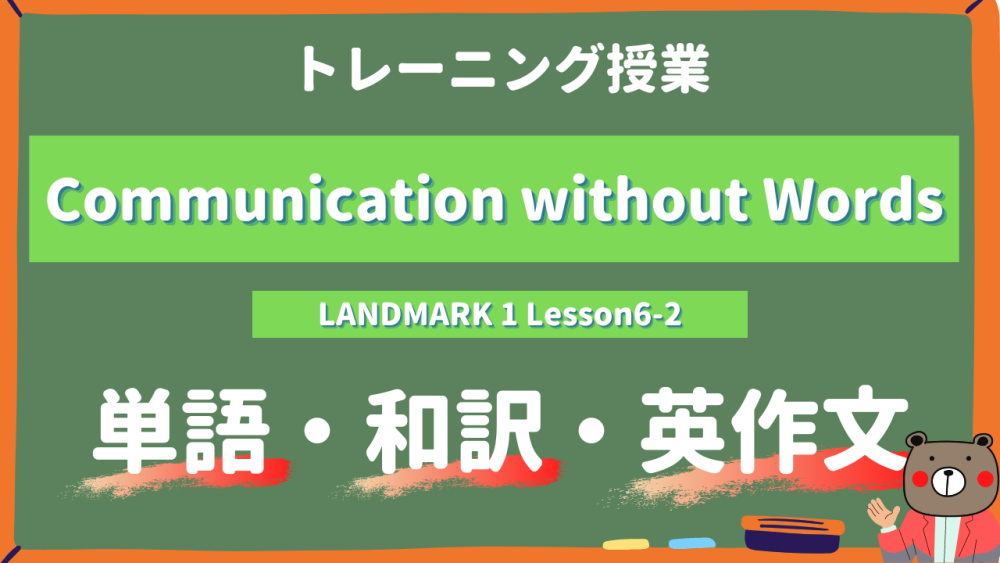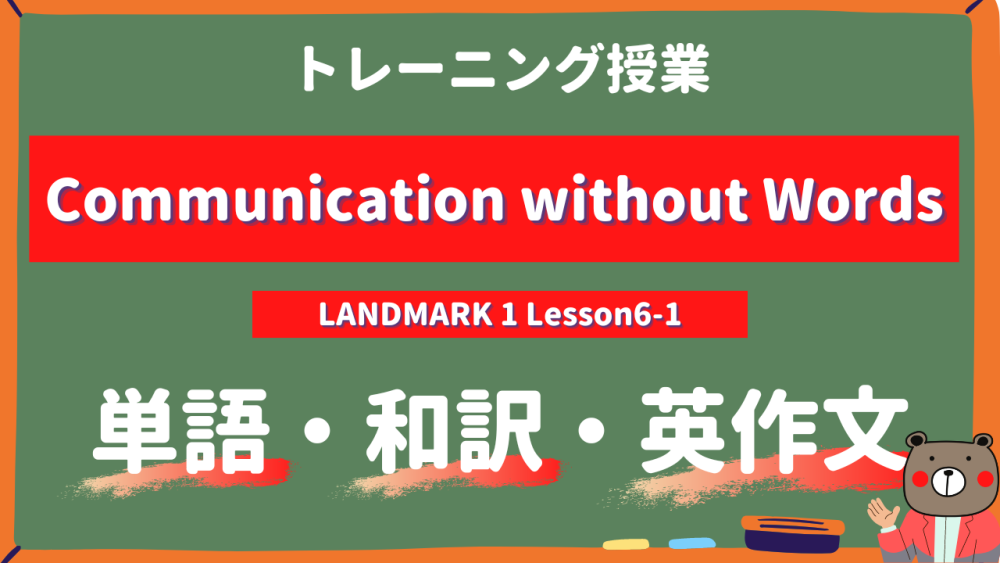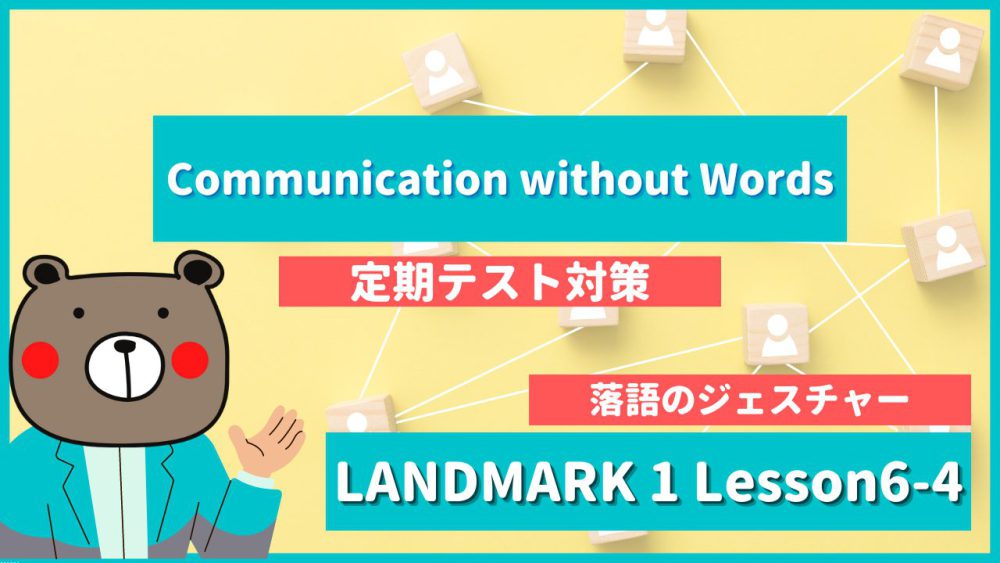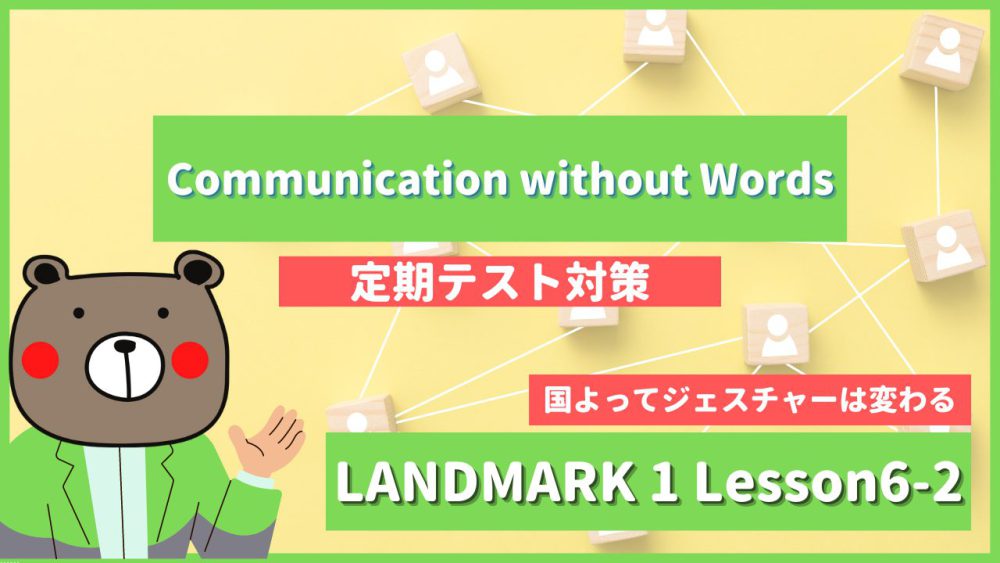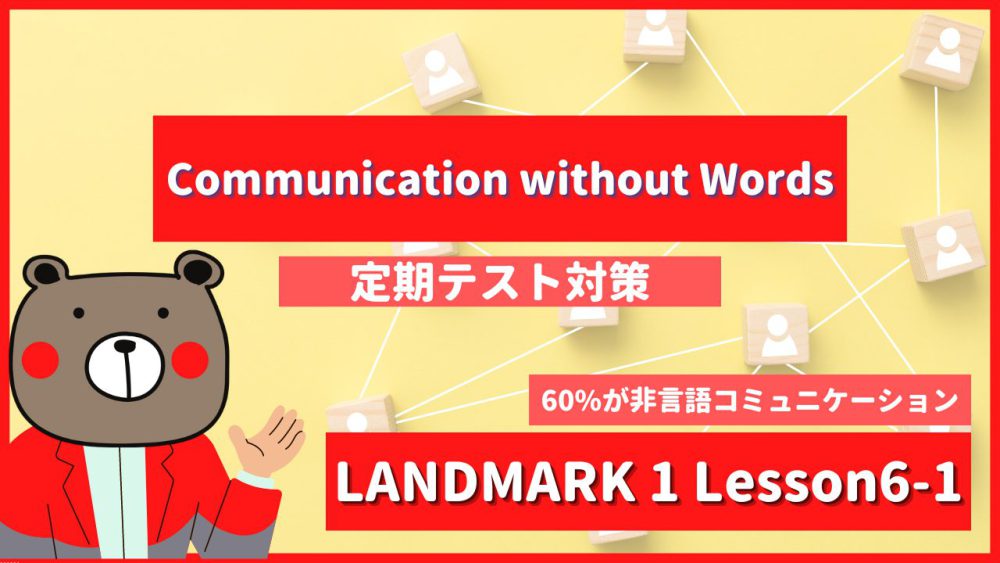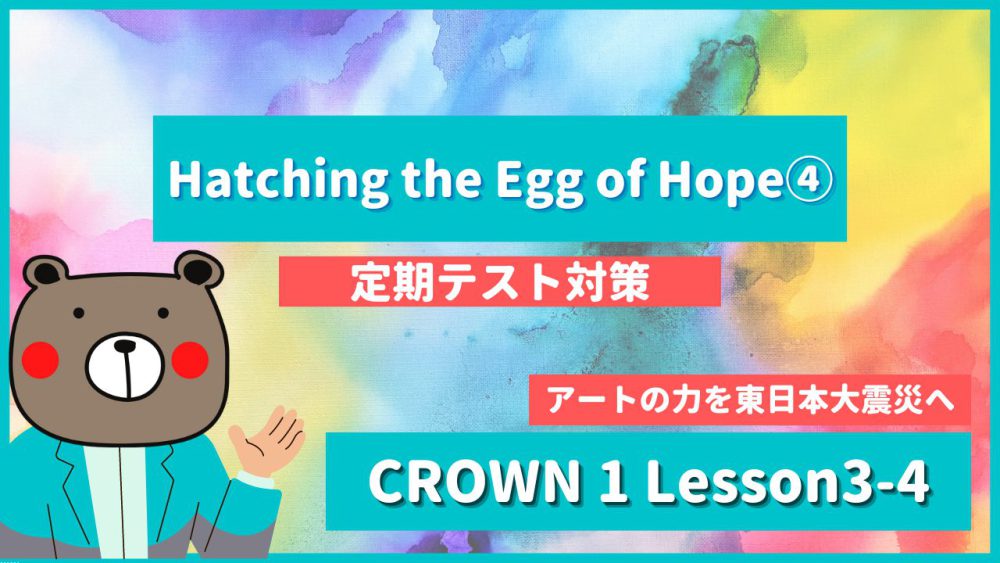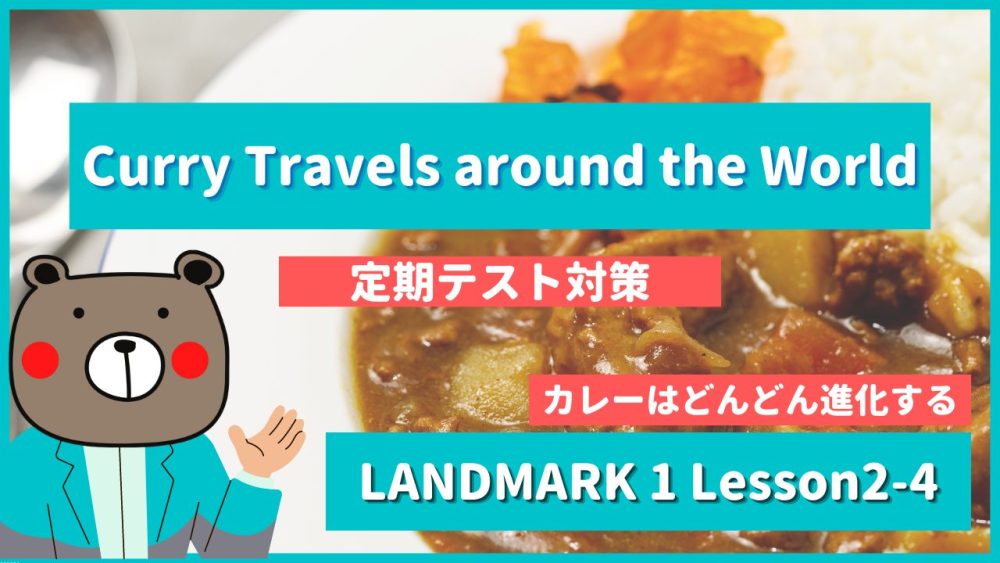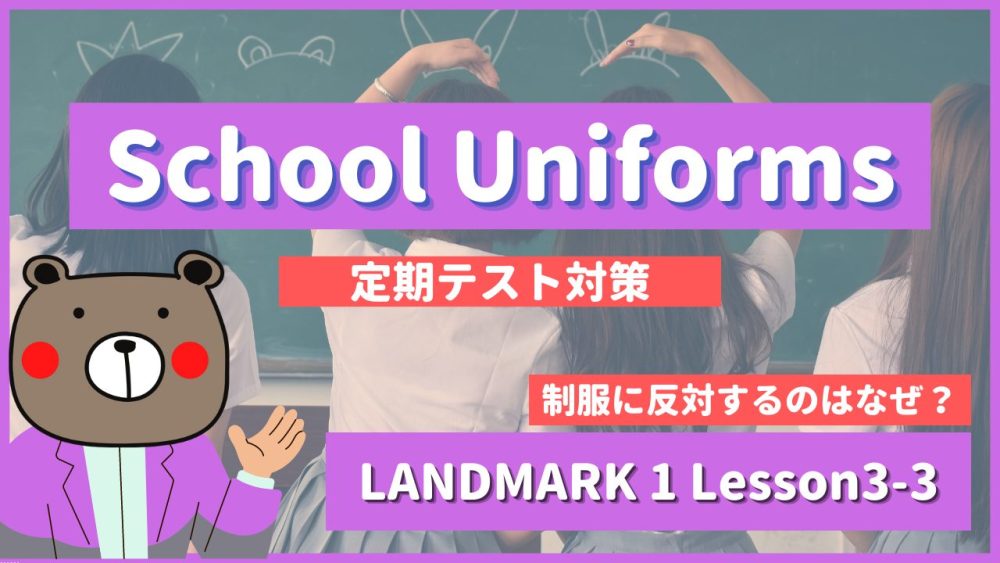▼音声で学びたい方はこちらへ🐻
現在撮影中❗️

▼LANDMARK1-高1《Lesson6》はこちらから🐻
- 授業前にひとこと
- 勉強のポイント
- 本文&和訳
- 重要単語
- 重要ポイント
- 【1】How did the Asian greeting gesture spread?
- 【2】How do Maori people in New Zealand greet?
- 【3】Different cultures have different types of non-verbal communication.
- 【4】Take greetings for example.
- 【5】We bow when we greet each other in Japan, while in many other Asian countries people press the palms of their hands together to greet people.
- 【6】This gesture spread through the introduction of Buddhism from India.
- 【7】In Western countries throughout Europe and America, however, it is common to shake hands or hug when you meet someone.
- 【8】There are also some unique greetings in the world.
- 【9】Maori people in New Zealand, for example, press their noses together when they greet.
- 【10】This is to show they share the breath of life.
- 【11】In Tibet, people greet each other by sticking their tongues out because it is regarded as a gesture of respect.
- 【12】Another example is that of the Kikuyu people in Africa.
- 【13】They greet each other by spitting on the other’s hand to take away evil and bring good luck.
授業前にひとこと


今回は、LANDMARK1-高1《Lesson6》について扱っていきます❗️
Lesson6のタイトルは…🐻
Communication without Words
という「言葉を使わないコミュニケーション」についてのお話です。
ちなみに、このLessonでは…
冒頭の Question を踏まえて文章を読む
のを意識してください❗️
さて、いつも授業前に説明することですが…
⇧に載せてあります『単語・和訳・英作文トレーニング』をテスト1週間前から毎日やってみてください❗️曖昧な理解がなくなり、成績が爆伸びします!!
コミュ英以外の定期テスト対策は?
現代文の定期テスト対策は こちら から
古文の定期テスト対策は こちら から
漢文の定期テスト対策は こちら から
teite channel をもっと活用する


▷ 解説記事のリクエスト
▷ 新着情報のキャッチ
▷ 定期テスト予想問題
▷ オリジナルグッズの購入
ができるようになっています🐻
teite channel の 公式LINEアカウント はこちら
勉強のポイント
①本文は、挨拶のジェスチャーに関するアジア、西洋諸国、そして特徴的な国々の例を紹介していることを理解する。
②単語・重要ポイントをインプットする。
③冒頭の Question を踏まえて文章を読む。
本文&和訳
Question5
How did the Asian greeting gesture spread?
アジアの挨拶のジェスチャはどのように広がりましたか?
Question6
How do Maori people in New Zealand greet?
ニュージーランドのマオリ族はどのように挨拶をしますか?
本文(Part3)
【5】Different cultures have different types of non-verbal communication.
それぞれの文化は、それぞれの非言語コミュニケーションの種類を持っています。
Take greetings for example.
挨拶を例に取り上げてみましょう。
We bow when we greet each other in Japan, while in many other Asian countries people press the palms of their hands together to greet people.
日本では、私たちはお互い挨拶をするときにお辞儀をしますが、一方で他のアジアの多くの国々では、合掌をして、人に挨拶をします。
This gesture spread through the introduction of Buddhism from India.
このジェスチャーはインドから仏教の伝来を通して広まりました。
In Western countries throughout Europe and America, however, it is common to shake hands or hug when you meet someone.
しかしヨーロッパやアメリカに広がる西洋の国々では、誰かに会うときには、握手するかハグをするのが一般的です。
【6】There are also some unique greetings in the world.
世界にはいくつかの独特な挨拶もあります。
Maori people in New Zealand, for example, press their noses together when they greet.
例えば、ニュージーランドのマオリ族は、あいさつをする時にお互いの鼻を合わせます。
This is to show they share the breath of life.
これは、彼らの活力を分かち合うことを示すためにあります。
In Tibet, people greet each other by sticking their tongues out because it is regarded as a gesture of respect.
チベットでは、人々はペロリと舌を出すことによってお互いに挨拶をします、なぜならそれは尊敬を表すジェスチャーと考えられているからです。
Another example is that of the Kikuyu people in Africa.
他のもう一つの例は、アフリカのキクユ族のそれです。
They greet each other by spitting on the other’s hand to take away evil and bring good luck.
彼らは、不吉を取り除いたり幸運をもたらすために、相手の手に唾を吐くことによって、お互いに挨拶をします。
重要単語


V : 動詞 , Ving : 動名詞 , Vpp : 過去分詞, O:目的語, C:補語
| greeting | 挨拶 |
| greet | 挨拶をする |
| Asian | アジアの |
| press | 〜を押す |
| Buddhism | 仏教 |
| Maori | マオリ |
| Tibet | チベット |
| stick | 〜を突き出す |
| tongue | 舌 |
| regard | 〜考える、見なす |
| Kikuyu | キクユ |
| spit | 唾を吐く |
| evil | 不吉、邪悪 |
| take A for example | Aを例にする |
| it is common (for A) to V | Vするのが普通である、一般的だ |
| regard A as B | AをBとみなす、考える |
重要ポイント
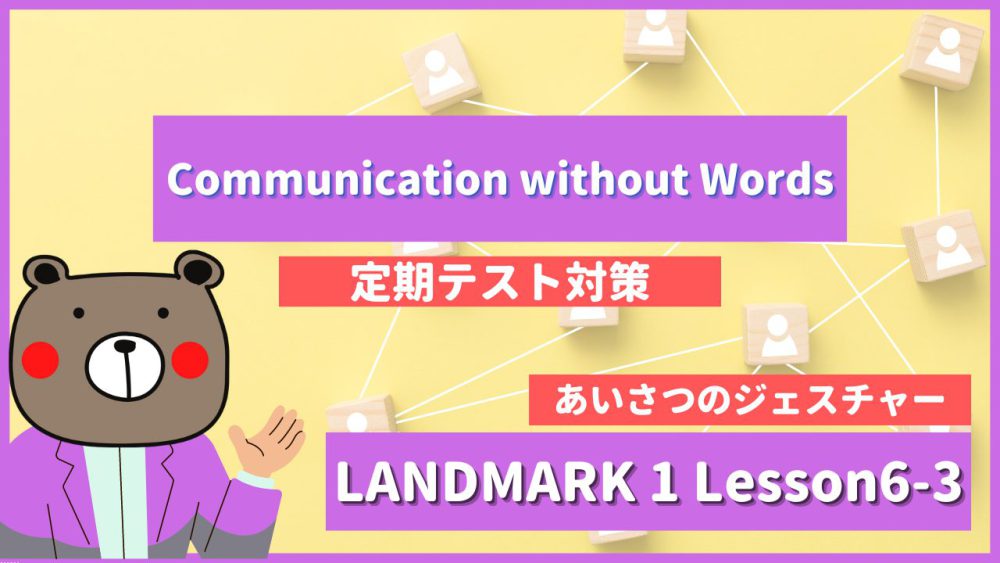

「ピンク」=重要ポイント
▼記号について
V : 動詞 Ving : 動名詞 Vpp : 過去分詞
【 】名詞句・節 〈 〉形容詞句・節 ( )副詞句・節
S:主語 O:目的語 C:補語 M:副詞
【1】How did the Asian greeting gesture spread?
《和訳》
アジアの挨拶のジェスチャはどのように広がりましたか?
《重要ポイント》
ここまで執筆完了❗️日々解説を加えていきます!


teite channel の 公式LINEアカウント はこちら
【2】How do Maori people in New Zealand greet?
《和訳》
ニュージーランドのマオリ族はどのように挨拶をしますか?
《重要ポイント》
【3】Different cultures have different types of non-verbal communication.
《和訳》
それぞれの文化は、それぞれの非言語コミュニケーションの種類を持っています。
《重要ポイント》
【4】Take greetings for example.
《和訳》
挨拶を例に取り上げてみましょう。
《重要ポイント》
【5】We bow when we greet each other in Japan, while in many other Asian countries people press the palms of their hands together to greet people.
《和訳》
日本では、私たちはお互い挨拶をするときにお辞儀をしますが、一方で他のアジアの多くの国々では、合掌をして、人に挨拶をします。
《重要ポイント》
【6】This gesture spread through the introduction of Buddhism from India.
《和訳》
このジェスチャーはインドから仏教の伝来を通して広まりました。
《重要ポイント》
【7】In Western countries throughout Europe and America, however, it is common to shake hands or hug when you meet someone.
《和訳》
しかしヨーロッパやアメリカに広がる西洋の国々では、誰かに会うときには、握手するかハグをするのが一般的です。
《重要ポイント》
【8】There are also some unique greetings in the world.
《和訳》
世界にはいくつかの独特な挨拶もあります。
《重要ポイント》
【9】Maori people in New Zealand, for example, press their noses together when they greet.
《和訳》
例えば、ニュージーランドのマオリ族は、あいさつをする時にお互いの鼻を合わせます。
《重要ポイント》
【10】This is to show they share the breath of life.
《和訳》
これは、彼らの活力を分かち合うことを示すためにあります。
《重要ポイント》
【11】In Tibet, people greet each other by sticking their tongues out because it is regarded as a gesture of respect.
《和訳》
チベットでは、人々はペロリと舌を出すことによってお互いに挨拶をします、なぜならそれは尊敬を表すジェスチャーと考えられているからです。
《重要ポイント》
【12】Another example is that of the Kikuyu people in Africa.
《和訳》
他のもう一つの例は、アフリカのキクユ族のそれです。
《重要ポイント》
【13】They greet each other by spitting on the other’s hand to take away evil and bring good luck.
《和訳》
彼らは、不吉を取り除いたり幸運をもたらすために、相手の手に唾を吐くことによって、お互いに挨拶をします。
《重要ポイント》


これで全て終了です❗️
「LANDMARK1-高1《Lesson6-3 | Communication without Words | p100~101》」おつかれさまでした🐻
Questionを踏まえて読解すれば、比較的話しの流れは掴みやすいですが、それが出来ていないと知らない熟語や構文が出てきたり、単語のレベル高かったりで、苦戦している人もいるのではないでしょうか❗️
復習&音読するのをお忘れなく!!
①授業前にひとこと、でも話しましたが…
⇧に載せてあります『単語・和訳・英作文トレーニング』をテスト1週間前から毎日やってみてください❗️曖昧な理解がなくなり、成績が爆伸びします!!
最後まで見てくださってありがとうございました!
またお会いしましょう!定期テストがんばれ〜🐻
じゃあね〜、バイバイ!!
